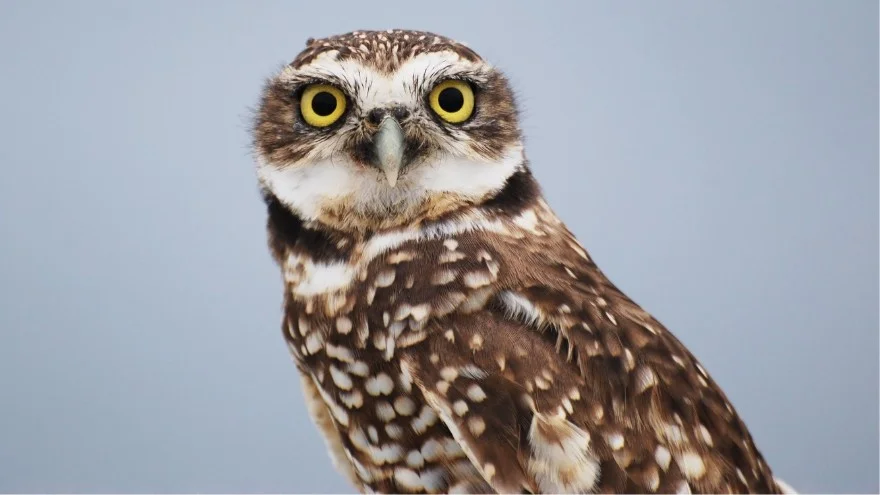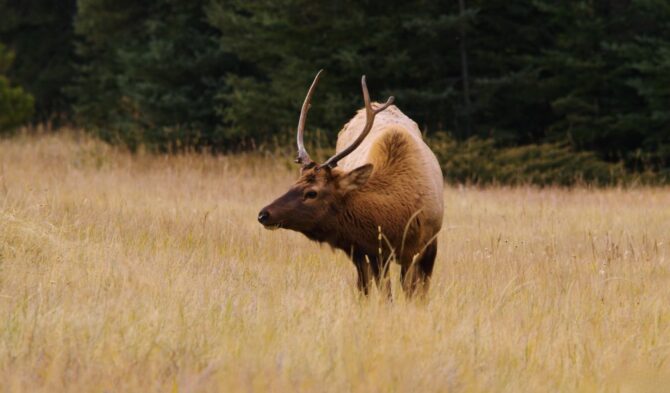Officially called the state of Washington, this region was named after the first president of the United States, George Washington.
It is bordered by the Pacific, Oregon, Idaho, and the Canadian province. It should not be confused with Washington DC, the capital of the USA.
Washington State contains a lot of animals, some of which are owls. The state is home to multiple owls, even more than a couple of other states. We’ll be taking a look at these creatures in the course of this article.
We’ve compiled the 15 species of owls in Washington State. They include the great horned owl, flammulated owl, barn owl, pygmy owl, and Northern hawk, among others.
Read on to discover the interesting facts about these birds, including how to identify the different species based on their appearance, sounds, and migratory patterns.
The 15 Species of Owls in Washington State
1. Burrowing Owl
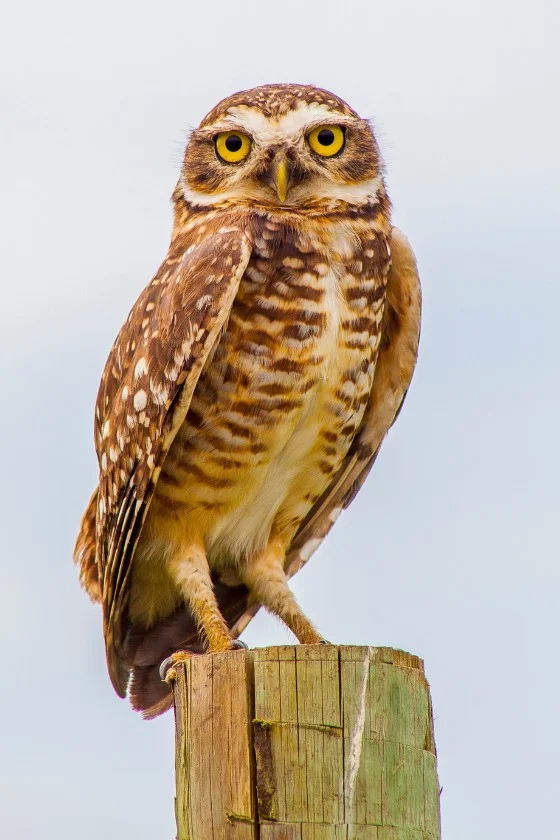
- Length: 7 to 11 inches
- Weight: 5 to 9 pounds
- Wingspan: 20 to 24 inches
- Scientific name: Athene cunicularia
The burrowing owl is a small bird with long legs that help it move in its surrounding. It doesn’t stay on trees like others but would rather live in prairies, deserts, grasslands, etc.
It got its name from where it lives. The burrowing owl stays in burrows, often those left by other animals.
The burrowing owl is a small bird, just a bit bigger than an American robin. It is known to have bright eyes, a yellow beak (or sometimes gray), and a flat facial disc.
It also has a brown head, and the wings are spotted. Females are slightly heavier than males, but the latter is lighter.
These birds stay on the eastern side of Washington State and usually during the breeding season. They use their long legs to hunt, sprinting after prey when hunting.
They can be active during the day but usually would prefer hunting when the heat is minimal.
2. Great Horned Owl

- Length: 18 to 25 inches
- Weight: 32 to 88 pounds
- Wingspan: 40 to 57 inches
- Scientific name: Bubo virginianus
The great horned owl is the most widely distributed true owl in North America, and it was made popular because it fits the textbook definition of an owl.1
It is also called the tiger owl or the hoot owl. You can find it around Washington State, where it inhabits deserts, prairies, mountains, etc.
The lower parts of the great horned owl are usually lighter than the upper parts, and there are barrings both at the lower parts and at the sides. The upper parts are colored a mottled brown, the same as the wings.
The great horned owl can be easily detected because of its call, but you may have a hard seeing it in its natural environments because it is a master at camouflage.
The main vocal sound is the hoot, but younger ones may hiss or shriek.
This bird is a big hunter that goes after what is available. However, its main preference seems to be rodents. It supplements rodents with birds, amphibians, and reptiles.
The great horned owl is nocturnal, so you can best sight it at night. Its outstanding features are yellow eyes and a tuft of hair staying close to the eyes.
3. Western Screech Owl
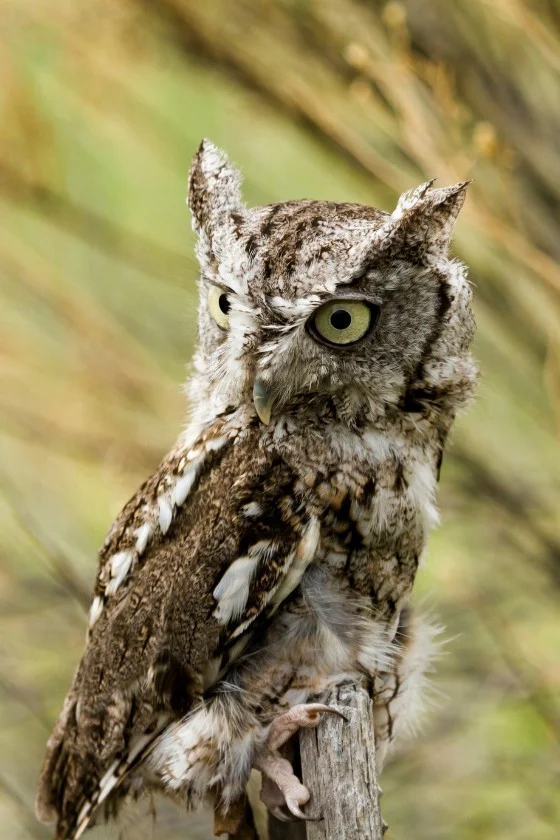
- Length: 8 to 10 inches
- Weight: 4 to 11 pounds
- Wingspan: 22 to 25 inches
- Scientific name: Otus kennicottii
The western screech owl is close relative to the eastern screech owl. It is a tiny bird that can be found in the North and Central parts of America.
It stays in the coastal parts of Washington state. These birds are hard to find because of their size and nocturnal lifestyle. The best way to know where a western screech owl is located is from the sound.
True to its name, this bird screeches. The sound is high-pitched and easy to pick up from a distance. It also makes other calls like barking, chuckling, and accelerated whistles.
When you see a western screech, the physical traits that would stand out are yellow eyes, a yellow bill, and a dim-colored plumage that’s either brown or dark gray.
Because of its size, the western screech owl often goes after small rodents. However, it has enough strength to tackle bigger animals like a rabbit. It also feeds on insects, birds, and crayfish.
4. Northern Saw-Whet Owl
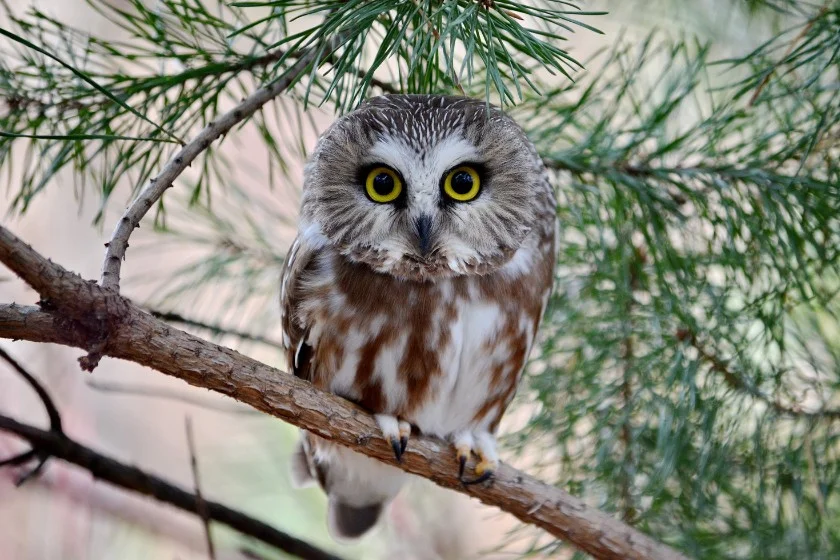
- Length: 7 to 9 inches
- Weight: 2 to 5 pounds
- Wingspan: 17 to 22 inches
- Scientific name: Aegolius acadius
The Northern saw-whet owl is also small, just like the Western screech. It belongs to the Aegolius genus and is considered one of the smallest owls in North America.
It is described as having yellow eyes, a heart-shaped face, and a mark V in between the eyes.
In Washington, the northern saw-whet is found year-round, and just like the Western screech, the saw-whet is hard to see because of its small size.
You can only know it’s there because of its vocals or if you’re chanced enough to find one sleeping in a tree cavity. It feeds on rodents, small birds, and shrews.
The best time to find a saw-whet owl is during its breeding period. Males make more sound than while searching for a potential mate.
If you also happen to live in an environment with a lot of saw-whet owls, you can attract them to where you live by setting up a nesting box.
5. Northern Hawk Owl
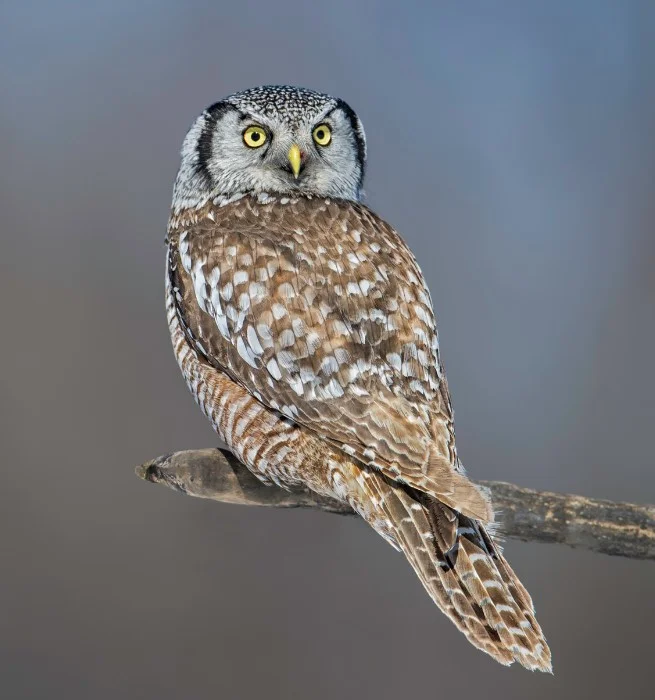
- Length: 14 to 18 inches
- Weight: 9 to 16 pounds
- Wingspan: 28 inches
- Scientific name: Surnia ulula
The Northern hawk owl is different from other species in that it behaves more like a hawk than an owl. That’s where it gets the name.
On the surface, it has all the characteristics of an owl with a round head, yellow eyes, and a brown body. However, it hunts with a sight like a hawk and even perches at the top of trees.
This bird is a rare sight in Washington, but there have been occasional reports of seeing it, which is why the hawk owl is on our list.
If you do get the opportunity to see one, it is hard to miss. The best part is that it is diurnal, so you needn’t wait for dusk to see one.
Because hawk owls hunt by sight, they usually do so by the day.2 However, they also hunt by night. They are migratory and can be found both in Canada and the United States.
6. Barn Owl
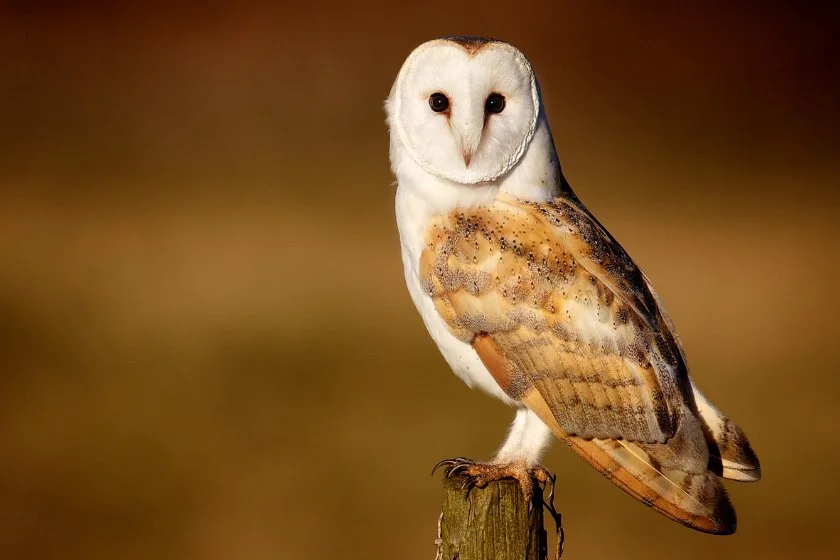
- Length: 13 to 16 inches
- Weight: 14 to 25 pounds
- Wingspan: 40 to 50 inches
- Scientific name: Tyto Alba
The barn owl has a bad reputation, more than many other species. It has unusual looks and a shrill voice that could bother those that know little about the species.
However, it is not dangerous. The barn owl got its name because it lives in a barn and other buildings.
The best way to recognize the species is by its face. Its face is shaped like a heart, and the eyes are large. It also doesn’t have ear tufts like the great horned owl.
It also comes with black eyes—which fuels the stereotype—as well as an overall pale brown look. It can be found all year in Washington state as it is non-migratory.
The barn owl is nocturnal, feeding mainly on rodents and other small mammals.
Some farmers enjoy having this bird on their farm as it helps with rodent control. Other prey includes birds, fish, amphibians, and insects.
7. Barred Owl
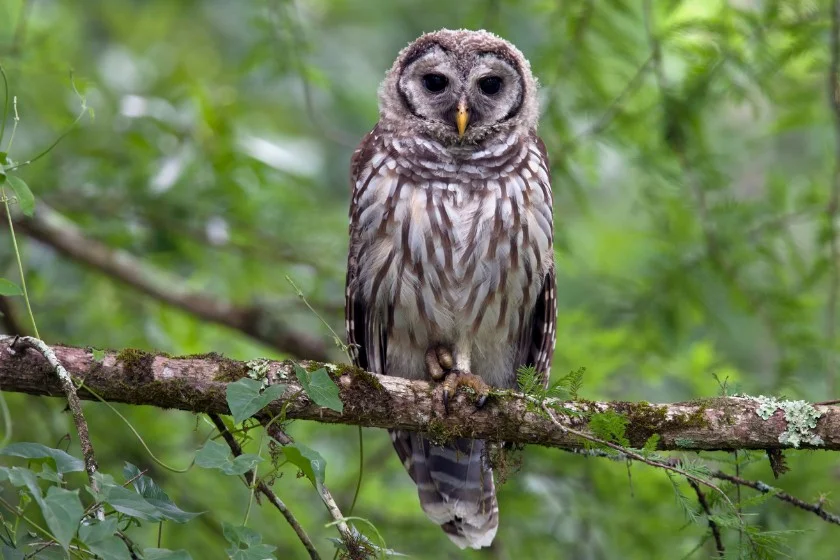
- Length: 17 to 20 inches
- Weight: 16 to 37 pounds
- Wingspan: 39 to 43 inches
- Scientific name: Strix varia
The barred owl is also called the hoot, striped, or northern barred owl. It is a true owl species of the Strigidae family and can be described as having brown and white colors.
It is large and quiet, hardly making noise. You might only hear it call out a few times per day.
The barred owl is so named because of the horizontal bars/stripes that decorate its feathers.
You’d find the stripes on the wings, tail, and back. It is also described as having a fairly large head, a pale facial disc, and a bill. It has no ear tufts.
In Washington, this bird stays in the Eastern and coastal regions. It is a nocturnal animal, sleeping throughout the day before starting its activities at sundown.
It often hunts small mammals, though it can go for amphibians and birds.
8. Northern Pygmy Owl
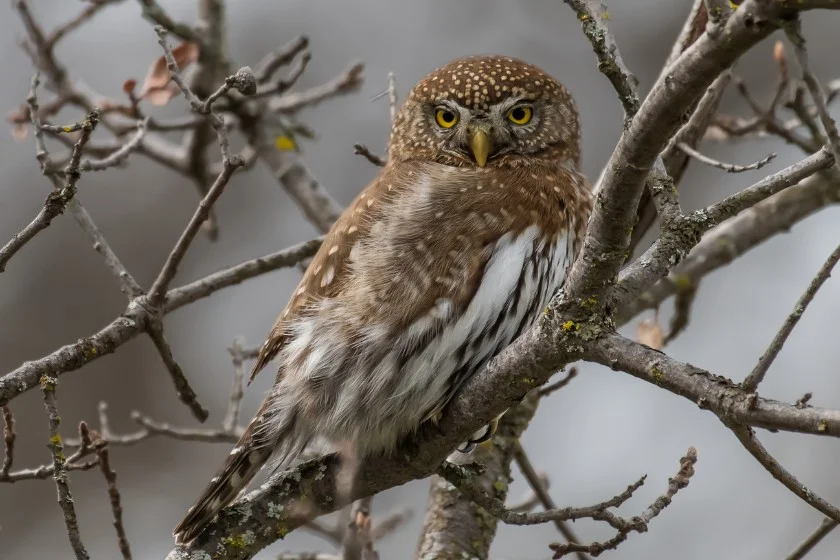
- Length: 6 to 7 inches
- Weight: 2 to 3 pounds
- Wingspan: 12 inches
- Scientific name: Glaucidium californicum
The Northern pygmy owl is a small, brown owl with white spots both on the head and plumage. It is a native of western North America.
In Washington, it stays on the eastern side. Its small size makes it a prime target for bigger owls and birds, so it protects itself in different ways. One of these is two white spots looking like eyes to scare predators.
The Northern pygmy is often compared to other small owls like the elf owl, though the latter is smaller in size.
The pygmy is characterized by a round head with white spots, a facial disc, and dark coloration on the breast, wing, and tail. It also has long feathers on the legs.
This bird stays in tree cavities, but unlike some other species, it doesn’t create the hole by itself.
Rather, it stays in holes left by other animals. It hunts during the day, feeding on small birds, mammals, and reptiles.
9. Flammulated Owl
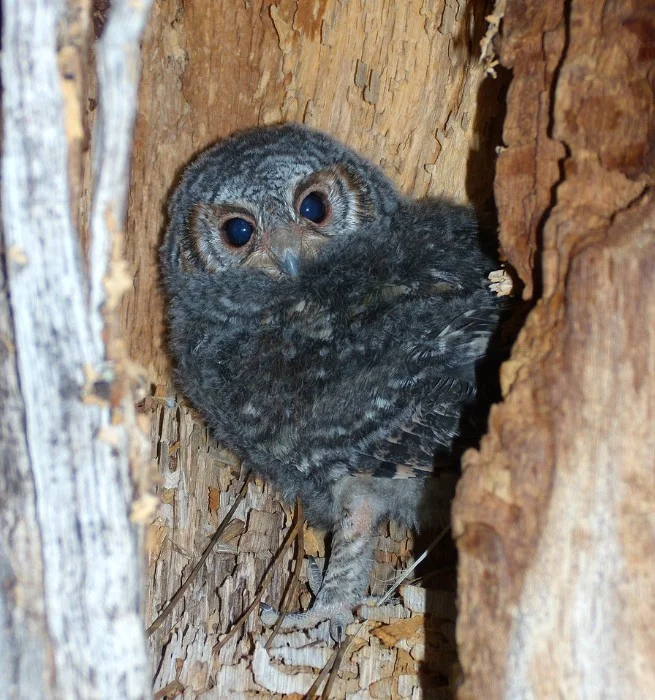
- Length: 6 to 7 inches
- Weight: 1.5 to 2 pounds
- Wingspan: 15 to 16 inches
- Scientific name: Psiloscops flammeolus
The flammulated owl is similar to the western screech owl, and it is a tiny owl about the size of a sparrow.
Though not the smallest species, it is tiny and hard to find. They often rest in trees during the day and hunt at night.
This species got its name from the flame-like marking on the face, which is its defining feature. It resembles the western screech owl and may sometimes be mistaken for it, but there are some differences.
The flammulated owl is smaller and has no ear tuft. Other physical traits include dark eyes and long wings.
The flammulated owl is both a hunter and prey. It feeds mainly on insects and has to avoid being eaten by other bigger owls and birds.
Its major defense tactic is the vocal call. For such a small bird, it has a loud sound that is meant to scare predators away.
10. Boreal Owl
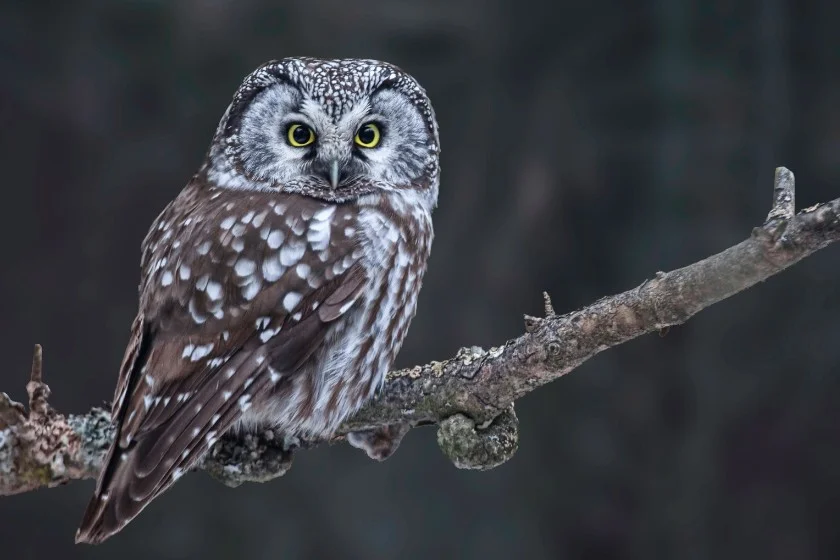
- Length: 8 to 11 inches
- Weight: 3 to 8 pounds
- Wingspan: 22 to 25 inches
- Scientific name: Aegolius funereus
The boreal owl can be found in North America and around Europe, where it bears a different name.
European countries call it the Tengmalm’s owl or the Richardson’s owl, though the second name is rare. It hardly migrates but might do so if there’s a food shortage in the area.
This creature is hardly seen because of its shyness towards humans. It tends to evade contact, and its nocturnal habit keeps it away from public view.
If you do see one, you’d recognize it by its brown feathers and streaks of white.
With birds like the boreal owl, you may have to be content with hearing the sound. It makes a lot of whistled toots at the same moment, especially during the breeding season.
This bird feeds on small animals like voles, bats, frogs, beetles, and birds.
11. Short-eared Owl
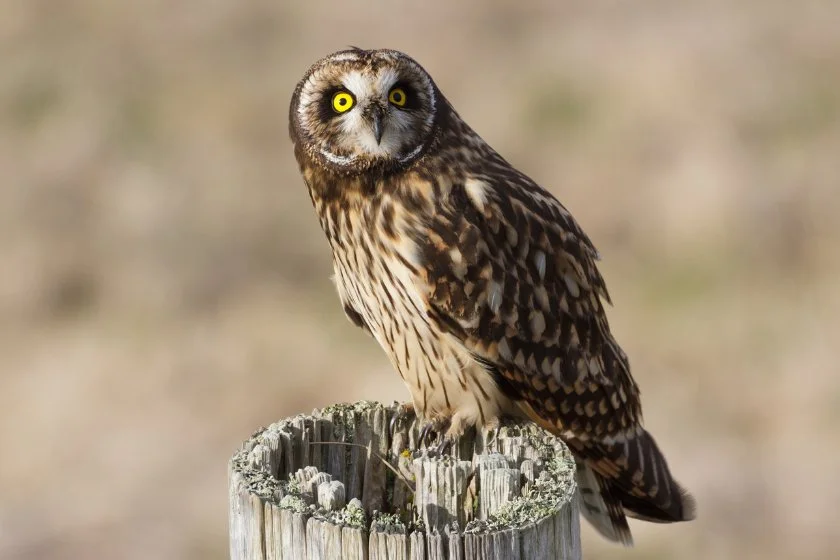
- Length: 14 to 17 inches
- Weight: 7 to 17 pounds
- Wingspan: 34 to 41 inches
- Scientific name: Asio flammeus
The short-eared owl is so named because of its short ear tufts which come in handy when it is hunting.
The ear tufts are tiny, which inspired the name. It has a cream face with dark outlines, yellow eyes, and brown and white skin.
You can find the short-eared owl all year in the state of Washington, and it is easy to spot both because of its obvious appearance and its diurnal lifestyle.
It is one of the few owls that are active during the day. Another reason you can easily find it is its call. It makes a raspy sound that’s very noticeable; it either sounds like waowk or a toot.
Its diet includes small mammals, voles, birds, and insects. Though it is diurnal, it hunts mainly at night.
12. Long-eared Owl

- Length: 14 to 16 inches
- Weight: 8 to 15 pounds
- Wingspan: 36 to 40 inches
- Scientific name: Asio otus
The long-eared owl is the opposite of the short-eared owl in that it has long ear tufts.
These tufts are quite noticeable and the best way to recognize the long-eared owl. They also have two lines between the eyes.
In Washington, these birds stay throughout the year and are either in the central parts of the eastern.
They are often found in semi-open habitats, and they feed on a variety of prey, including birds and insects.
The long-eared owl has a slim figure and long wings, and it’s admirable to watch it fly with those wings spread out.
The plumage is a combination of dark brown and gray, helping it go unnoticed amongst the trees.
13. Great Gray Owl
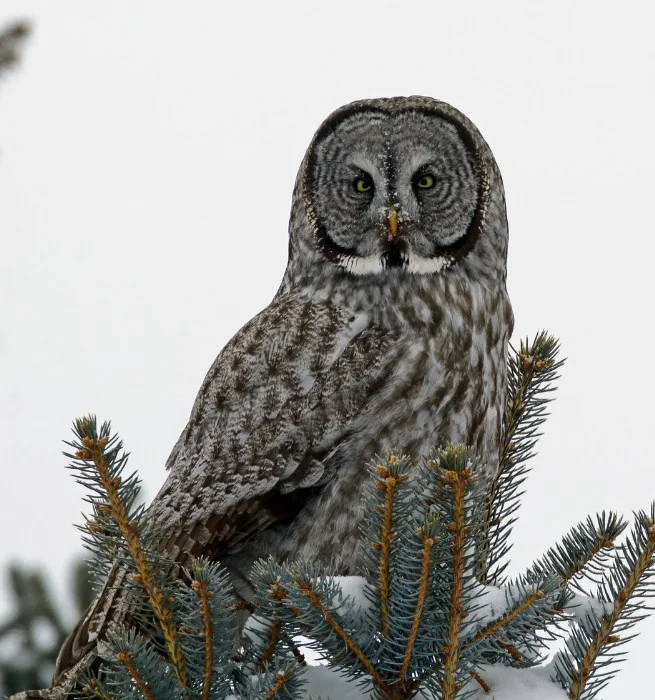
- Length: 24 to 33 inches
- Weight: 25 to 60 pounds
- Wingspan: 54 to 60 inches
- Scientific name: Asio flammeus
The great gray owl is a large bird, surpassing the great horned owl, and is considered one of the biggest owls in the United States. In size, it can be compared to a goose or a crow.
Washington’s residents or visitors can find these owls on the eastern side, living in coniferous forests.
Just as the name implies, the great gray owl is made up mainly of a gray color. Its face and upper parts are all gray, with the lower parts being lighter with some streaks of black on them.
Underneath its beak, it has a white collar that looks like a bow tie. Altogether, the great gray owl looks like it’s going for a dance!
Great gray owls are hard to find, however, because of their natural dislike for humans and human settlement.
They tend to avoid being around us, and they don’t make enough sounds for you to spot them. You might only be lucky to sight one from a distance at night. They feed on small mammals.
14. Spotted Owl

- Length: 18 to 25 inches
- Weight: 32 to 88 pounds
- Wingspan: 40 to 57 inches
- Scientific name: Bubo virginianus
The spotted owl is just as spotted as the name implies, but its main color is brown.
The white spots are usually at the center and less on the back. It usually stays in forests in Washington, but it is quite rare. Sighting one can be considered a lucky treat.
The sound of any owl can be used to detect it, and for the spotted owl, all you should do is listen out for its hoot. It is loud and goes a far distance, carrying into the night.
These birds are protected by the federation to keep their dwindling population from going down further, but they still face threats from habitat loss. They feed on small mammals and birds.
15. Snowy Owl
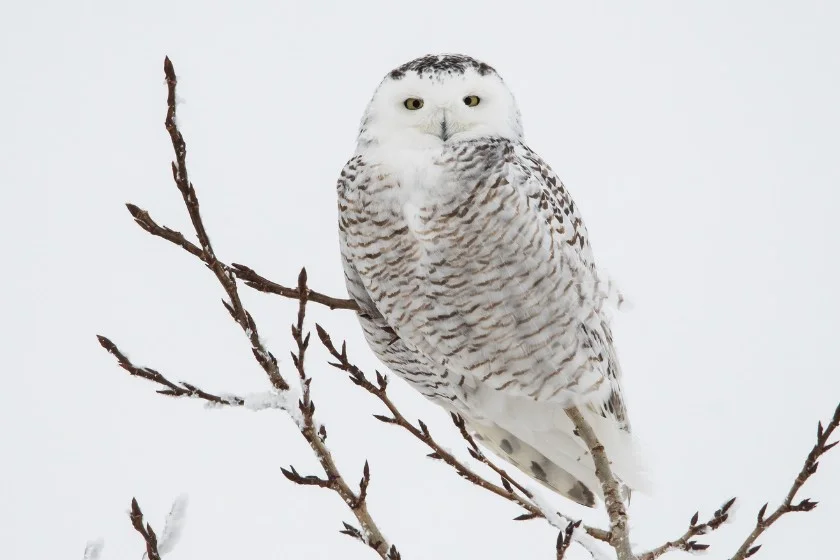
- Length: 21 to 28 inches
- Weight: 56 to 104 pounds
- Wingspan: 50 to 57 inches
- Scientific name: Bubo scandiacus
The snowy owl is a nomad, so do not expect it to remain in Washington (or any other state) throughout the year.
It lives mainly in the arctic region but migrates to the United States during the winter. It is not often seen in Washington but can migrate there in some years.
What makes the snowy owl a formidable hunter is its ability to find prey both during the day and at night. It feeds on almost everything.
Its striking feature is the white coat, and it goes by other names like artic owl, polar owl, and white owl.
Coloration is the best way to differentiate between genders and ages. If it has a lot of visible brown bars, it is most likely a female.
Males tend to be whiter overall. Also, younger ones have more black spots than older ones.
Conclusion
There are different species of owls in Washington state, numbering 15 in total. Some of them can be seen all year, while others have specific seasons and regions they stay in.
Owl-watching can be interesting, especially if you’re lucky to sight the rare ones. Some are harder to spot than others because of factors like size, personality, and nocturnal lifestyle.
Next up…
References & Notes
- Great Horned Owl. The Peregrine Fund.
- Geggel N. 2022. Are All Owls Actually Night Owls? Live Science.
